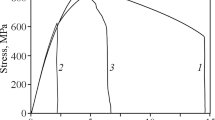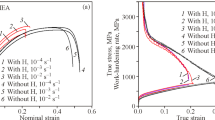Abstract
A sample plate of HY 130 steel (5 pet Ni-0.5 pet Cr-0.5 pet Mo-0.1 pet V-0.1 pet C) was found to be quite susceptible to temper embrittlement. Step-cooling produced a shift in transition temperature of 583 K (310°C). In the step-cooled condition the plane strain stress intensity threshold for crack growth in 0.1 N H2SO2 was about 22 MNm-3/2 (20 ksi √in. ) and the fracture mode was inter granular, whereas in the unembrittled condition the threshold for a 1.27 cm (1/2 in.) plate (not fully plane strain) was around 104.5 MNm-3/2 (95 ksi Vin. ) and the fracture mode was mixed cleavage and microvoid coalescence. The interaction between the impurity-induced and the hydrogen embrittlement is discussed in terms of Oriani’s theory of hydrogen embrittlement.
Similar content being viewed by others
References
Electron Fractography Handbook, Supplement II, AFMLTR 64416, March, 1968, Section B.
U. Q. Cabrai, A. Hache, and A. Constant:C. R. Acad. Sci., Paris, 1965, vol. 260, pp. 6887–90.
D. Kalderon:Inst. Meek Eng., London, 1972, vol. 186, pp. 341–77.
J. R. Low, D. F. Stein, A. M. Turkalo, and R. P. Laforce:Trans. TMS-AIME, 1968, vol. 242, p. 14.
B. J. Schulz and C. J. McMahon, Jr.: inTemper Embrittlement of Alloy Steels, ASTM STP 499, pp. 104–35, ASTM 1972.
B. F. Brown:Mater. Res. Stand, ASTM 1966, vol. 6, p. 129.
W. F. Brown, Jr. and J. E. Scrawley:Plane Strain Crack Toughness of High Strength Metallic Materials, ASTM STP 410, ASTM 1972.
J. A. Kies, H. L. Smith, H. E. Romine, and H. Bernstein: inFracture Toughness Testing and Its Applications, ASTM STP 381, ASTM, Phila., 1965.
C. J. McMahon, Jr.: inTemper Embrittlement in Steel, ASTM STP 407, pp. 127–67, ASTM, Phila., 1968.
K. Yoshino, H. C. Feng, and C. J. McMahon, Jr.:Proc. Internl. Conf. on Stress Corrosion Cracking and Hydrogen Embrittlement of Iron Base Alloys, Unieux-Firminy, France, June 1973.
R. A. Oriani:Ber. Bunsenges. Phys. Chem., vol. 76, 1972, pp. 848–57; alsoProc. Inteml. Conf. on Stress Corrosion Cracking and Hydrogen Embrittlement of Iron Base Alloys, Unieux-Firminy, France, June 1973.
J. C. M. Li, R. A. Oriani, and L. S. Darken:Z. Phys. Chem., (N. F.) vol. 49, 1966, p. 271.
Author information
Authors and Affiliations
Additional information
Formerly Research Fellow, Department of Metallurgy and Materials Science, University of Pennsylvania
Rights and permissions
About this article
Cite this article
Yoshino, K., McMahon, C.J. The cooperative relation between temper embrittlement and hydrogen embrittlement in a high strength steel. Metall Trans 5, 363–370 (1974). https://doi.org/10.1007/BF02644103
Received:
Published:
Issue Date:
DOI: https://doi.org/10.1007/BF02644103




